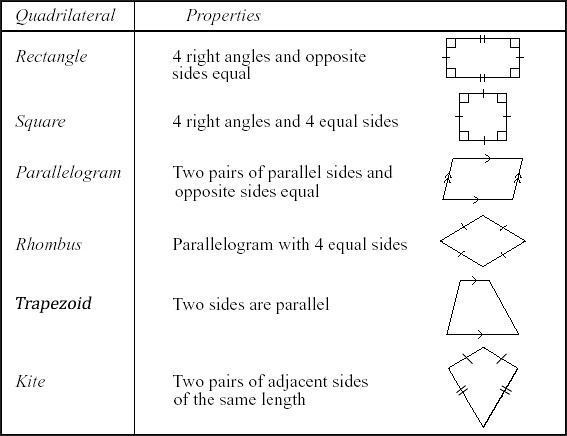Vocabulary
Parallelogram- Opposite sides are parallel and congruent. Opposite angles are congruent.
Rectangle- Parallelogram with four right angles.
Rhombus- Parallelogram with four congruent sides.
Square- Parallelogram four congruent sides and four right angles.
Trapezoid- Exactly one pair of opposite sides is parallel.

Examples
A quadrilateral is a polygon with four sides.
There are many special
 types of quadrilateral.
types of quadrilateral.A parallelogram is a quadrilateral in which both pairs of opposite sides are parallel.

A parallelogram also has the following properties:
- Opposite angles are congruent;
- Opposite sides are congruent;
- Adjacent angles are supplementary;
- The diagonals bisect each other.

A rectangle has all the properties of a parallelogram, plus the following:
- The diagonals are congruent.
A rhombus is a parallelogram with four congruent sides. The plural of rhombus is rhombi. (I love that word.)

A rhombus has all the properties of a parallelogram, plus the following:
- The diagonals intersect at right angles.

A trapezoid is a quadrilateral with exactly one pair of parallel sides. (There may be some confusion about this word depending on which country you're in. In India and Britain, they say trapezium; in America
 , trapezium usually means a quadrilateral with no parallel sides.)
, trapezium usually means a quadrilateral with no parallel sides.) 
An isosceles trapezoid is a trapezoid whose non-parallel sides are congruent.

A kite is a quadrilateral with exactly two pairs of adjacent congruent sides. (This definition excludes rhombi. Some textbooks say a kite has at least two pairs of adjacent congruent sides, so a rhombus is a special
 case of a kite.)
case of a kite.) 
A scalene quadrilateral is a four-sided polygon that has no congruent sides. Three examples are shown below.

Venn Diagram of Quadrilateral Classification
The following Venn Diagram shows the inclusions and intersections of the various types of quadrilaterals.
http://hotmath.com/hotmath_help/topics/quadrilaterals.html
Video Help
https://www.youtube.com/watch?v=xoXLb0WRBMA
https://learnzillion.com/lessons/2936-classify-various-quadrilaterals-by-describing-their-properties
https://www.youtube.com/watch?v=hY5KDuDap00

No comments:
Post a Comment